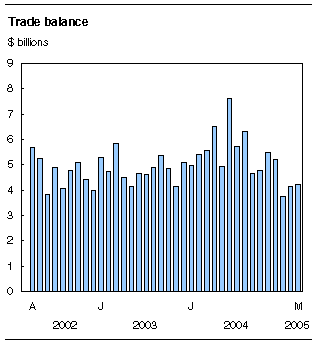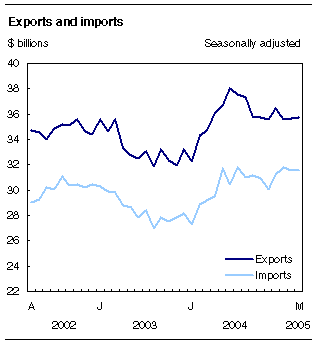
















 |
|
 |                |
Information identified as archived is provided for reference, research or recordkeeping purposes. It is not subject to the Government of Canada Web Standards and has not been altered or updated since it was archived. Please "contact us" to request a format other than those available.

|

Wednesday, May 11, 2005 Canadian international merchandise tradeMarch 2005Canada's merchandise trade with the world remained relatively stable in March as imports stayed flat and declines in automotive products and industrial goods and materials dampened export growth. 
Exports managed a marginal 0.2% increase to $35.8 billion, led by gains in energy products and machinery and equipment. Imports remained unchanged at just over $31.5 billion. As a result, the nation's merchandise trade surplus edged up $80 million from February's revised figure to $4.2 billion.
Trade slipped on both fronts with the United States, while it rose slightly with the rest of the world. The trade surplus with the United States held steady at $8.1 billion, and the trade deficit with all other trading partners remained at $3.9 billion. Both exports and imports of automotive products fell in March, as soaring gasoline prices apparently slowed consumer traffic in showrooms across North America. Exports of automotive products fell 7.6% to $6.9 billion while imports of automotive products declined 4.0% to $6.1 billion. Both of these values were the lowest since January 2004, and export levels were the third lowest since August 1998. Big gain in energy exportsEnergy exports recorded their biggest gain in three months in March. Exports of energy products increased 10.6% to $6.2 billion, driven by an 11.6% rise in natural gas as well as gains in crude petroleum (+7.5%) and other energy products (+13.6%). An increase in volumes accounted for the gain in crude petroleum exports while an equal mix of higher volumes and higher prices explained the jump in natural gas exports. Exports of petroleum and coal grew 13.3% to $1.1 billion as coal prices moved upward. Machinery and equipment exports advanced 3.6% in March, the third consecutive monthly increase. After falling during the latter half of 2004, this sector has regained ground, returning to August 2004 levels of $7.9 billion. A 10.0% decline in wheat exports led the drop in exports of agricultural and fishing products, which dropped 2.3% to $2.4 billion. Falling prices accounted for approximately two-thirds of the wheat decrease. Exports of industrial goods and materials fell from February's record-high of $6.9 billion to $6.7 billion. Chemicals, plastics and fertilizers and metal ores were the main contributors to the drop. Exports of metals and alloys went against the grain, rising 1.1% in March. Exports of nickel and alloys as well as zinc and alloys rose considerably, primarily as a result of China's growing demand for these materials. 
Rising business investment fuelling imports of machinery and equipmentA combination of higher corporate profits and low interest rates has fuelled business investment in recent months. Machinery and equipment imports, which reached $9.0 billion in March, have risen for four consecutive months. Imports in the machinery and equipment sector are 7.5% higher than March 2004. Growth in the oil and gas industry coupled with expansion in other mining activities in Canada has meant much higher imports of other industrial machinery and excavating machinery, in particular. Imports of other industrial machinery have been strong in the first three months of 2005, hitting $1.4 billion in March, 14.6% higher than a year ago. Excavating machinery imports have been on the rise since September, with the exception of a slight dip in March. Imports of industrial goods and materials recorded a 0.8% increase over February, led by gains in metals and metal ores. Imports of metals and metal ores hit a record-high in March, climbing to $2.1 billion. All commodity groups in this sub-sector contributed to the growth, with the exception of other iron and steel products, which fell 2.8% from their February high. Higher imports of crude petroleum (+7.9%) and other energy products (+14.7%) contributed to rising imports of energy products. Imports of agricultural and fishing products fell 2.1% to $1.8 billion, $38 million below January's high. Out of 16 major groups, 11 declined. Imports of fresh vegetables were up in February and March (+17.5% combined) as grocery retailers plumped up their offerings. As of January 1, 2005, the 10-year implementation period of the Agreement on Textiles and Clothing came to a close. In the first quarter of 2005, imports of textile fabricated materials, which include broad woven fabric, yarns, and threads, were up only slightly over the first three months of 2004. Textile imports in 2005 were below those recorded in 2003. Imports of apparel and apparel accessories edged up 0.3% in March, following a 9.7% increase in February. First quarter 2005 imports were up 14.7% over the first three months of 2004. For more information on the textile and clothing industries, consult the article Stretching or Shrinking? The Textile and Clothing Industries in Canada that is available free online (11-621-MIE2005022). Available on CANSIM: tables 228-0001 to 228-0003 and 228-0033 to 228-0046. Definitions, data sources and methods: survey numbers, including related surveys, 2201, 2202 and 2203. The March 2005 issue of Canadian International Merchandise Trade, Vol. 59, no. 3 (65-001-XIB, $15/$151) is now available. The publication includes tables by commodity and country on a customs basis. Current account data (which incorporate merchandise trade statistics, service transactions, investment income and transfers) are available quarterly in Canada's Balance of International Payments (67-001-XIE, $32/$100). Merchandise trade data are available in PDF format on the morning of release. For more information on products and services, contact Anne Couillard, (1-800-294-5583; 613-951-6867). To enquire about the concepts, methods or data quality of this release, contact Diana Wyman (613-951-3116), International Trade Division.
| |||||||||||||||||||||||||||||||||||||||||||||||||||||||||||||||||||||||||||||||||||||||||||||||||||||||||||||||||||||||||||||||||||||||||||||||||||||||||||||||||||||||||||||||||||||||||||||||||||||||||||||||||||||||||||||||||||||||||||||||||||||||||||||||||||||||||||||||||||||||||||||||||||||||||||||||||||||||||||||||||||||||||||||||||||||||||||||||||||||||||||||||||||||||||||||||||||||||||
|
|
|